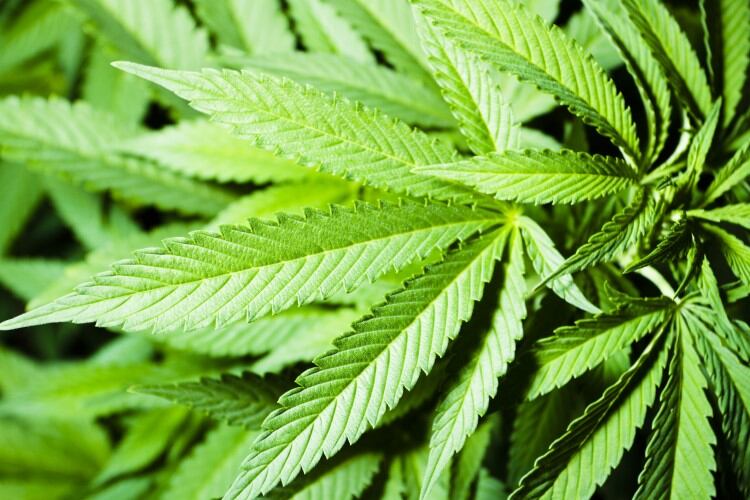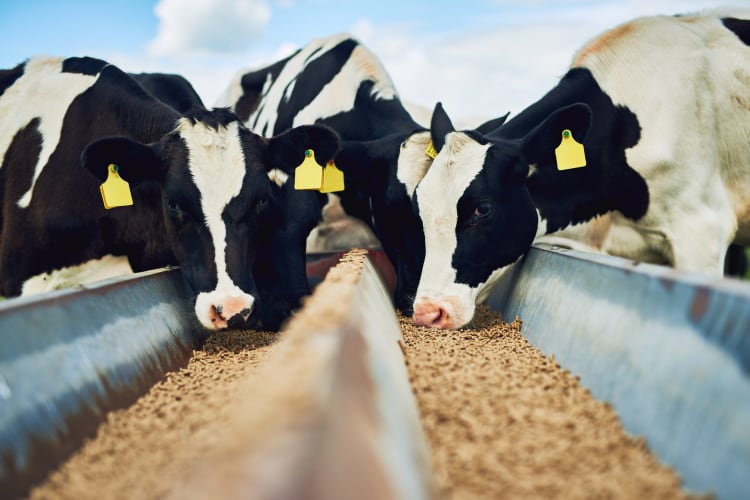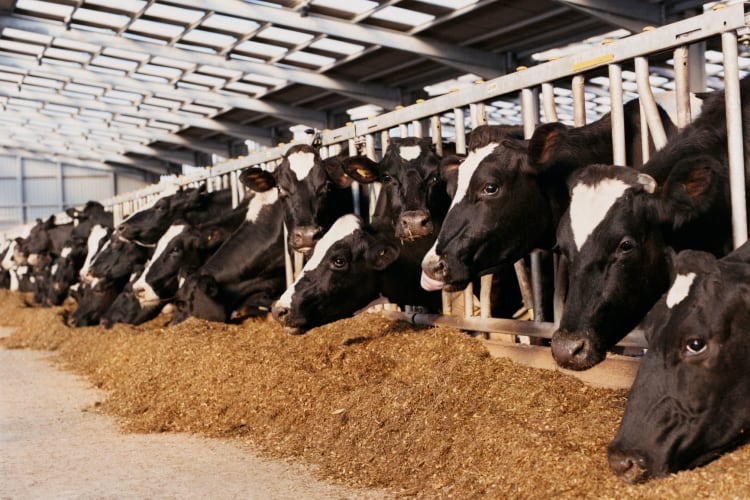Industrial hemp is a versatile crop that can be processed into different products. It’s highly regarded for its strong fibers and seed oil and, unlike marijuana, hemp contains only small traces of the psychoactive substance tetrahydrocannabinol (THC). This versatility has led to questions if the plant could be utilized as animal feed. But scientific research into this type of application and its effects on dairy cows and their milk remains limited.
In recent years, research into the nutritional benefits of hemp for dairy cows has been carried out. Scholars from Kansas State’s College of Veterinary Medicine concluded that all parts of the hemp plant would be nutritious for cows and reduce stress1. Their experiment also proved that cannabinoids were absorbed in the animal ‘quite quickly’, leading to fresh questions about the compounds’ concentration and effects in dairy food production.
Of particular importance to humans is what happens with THC when ingested by cows. The psychoactive substance, which is present at low levels in hemp, can however reach higher levels in cows as they require a large amount of feed each day.
In November 2022, researchers from the German Federal Institute for Risk Assessment (BfR) and the Chemical and Veterinary Analytical Institute Münsterland-Emscher-Lippe (CVUA-MEL) released a study that shows that humans who consume milk derived from hemp-fed cows could also ingest more than the maximum acceptable dose of Δ9-THC. The paper, published in Nature Food2, is notable for showing in detail how several different cannabinoids transferred from the animals to milk.
To differentiate between the non-psychoactive THCa and the psychoactive THC, for example, the researchers used a special method that allowed them to estimate the levels of different compounds present in the animals, their milk, and to assess the risks for consumers.
A model was then developed, which could be used to simulate exposure scenarios.
Drowsy cows and THC-rich milk
The experiment involved two feeding phases. During the adaptation period, dairy cows were fed whole plant hemp, which has very low cannabinoid concentration. Then, hemp silage with a higher cannabinoid concentration – i.e. made from leaves, flowers and seeds - was fed. The study recorded no physiological effects in the first instance, but in the second, there was a ‘significant’ effect to both milk yield and animal health. The researchers observed behavioural changes, such as increased yawning, prolapse and salivation, as well as decreased respiratory levels.
Meanwhile, it was concluded that feeding hemp silage ‘resulted in measurable levels of ∆9-THC, ∆9-THCA, ∆9-THCV, CBD, CBN and CBDV in cow’s milk at the end of the adaptation period and during the exposure period’.
“Maximum values for other cannabinoids in milk were 1.9 (∆9-THCA), 8.0 (∆9-THCV), 2.5 (CBN) and 10.1 µg per kg body weight (CBDV). On the last day of the depuration period, ∆9-THC (group L: 1.4 ± 0.4 µg per kg; group H: 5.0 ± 0.6 µg per kg) and CBD (group L: 7.0 ± 1.9 µg per kg; group H: 16.2 ± 2.6 µg per kg) were still detectable in milk,” the paper reads.
“At the end of the exposure period, the levels in milk were 6 - 26 times higher for ∆9-THC, 3 - 5 times higher for ∆9-THCV and 11 - 32 times higher for CBD than the corresponding blood plasma levels, pointing to the accumulation potential of the substances in cow’s milk. In contrast, ∆9-THCA did not accumulate in milk.”
Risks to consumers
The research also measured the exposure to humans who consumed the milk produced by the hemp-fed cows. The study showed that exposure to THC – the psychoactive substance that gets people ‘high’ - could exceed the acute reference values in some consumers. Even milk produced during the adaptation period - when cows had been fed a whole-plant diet low in cannabinoids - resulted in the acute reference dose ‘being exceeded by 1.5-fold in infant high consumers’, the researchers noted.
They also highlighted that even the non-psychoactive THCA could pose a risk if present in fresh milk, since the substance could be converted into THC during thermal processing, such as that required to produce UHT milk.
The scholars conclude that while ‘transfer rates of the examined cannabinoids from feed to milk were less than 1%’, due to the high feed intake, cow’s milk reached substantial levels of Δ9-THC such that the exposure might exceed [the acute reference dose] in some population groups’.
Sources:
1. Short term feeding of industrial hemp with a high cannabidiolic acid (CBDA) content increases lying behavior and reduces biomarkers of stress and inflammation in Holstein steers, DOI: 10.1038/s41598-022-07795-z
2. Transfer of cannabinoids into the milk of dairy cows fed with industrial hemp could lead to Δ9-THC exposure that exceeds acute reference dose, Wagner, B., Gerletti, P., Fürst, P. et al., DOI: 10.1038/s43016-022-00623-7



